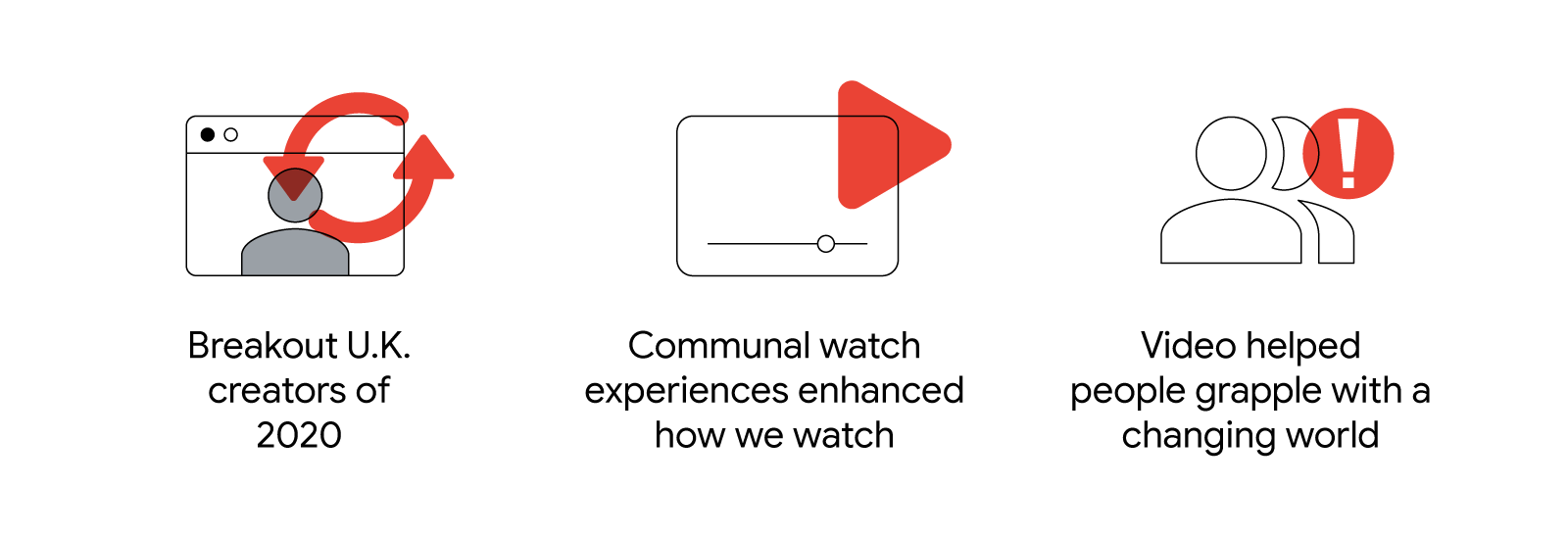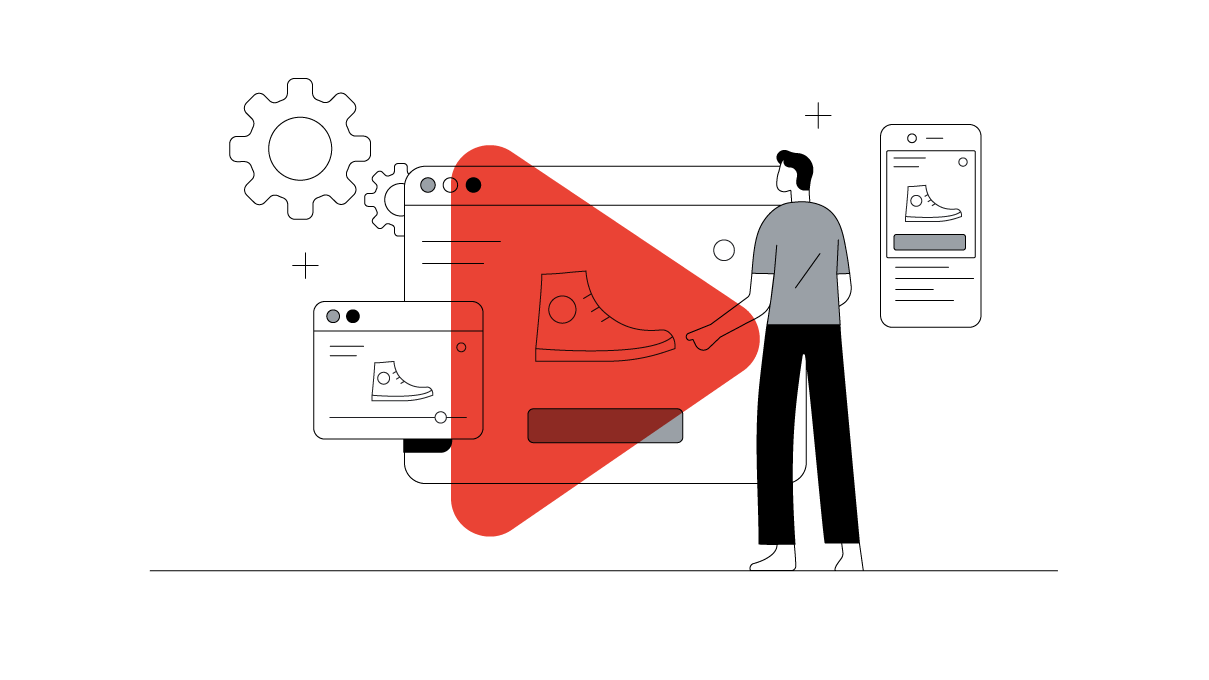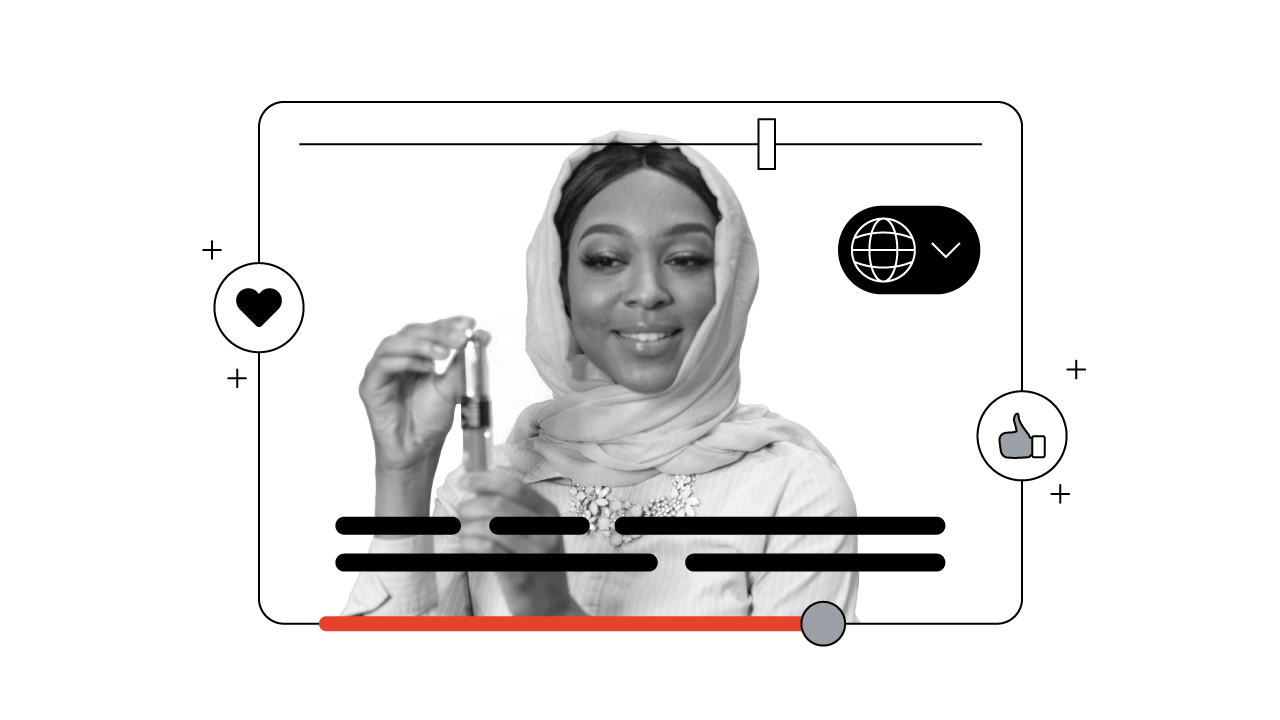YouTube’s billion-plus hours of daily watchtime offers an unparalleled window into the state of culture around the world. In the U.K. alone, the average online adult watches 46 minutes of YouTube per day, and it’s used by over 96% of online adults in the U.K. each month on average.1
It’s a window that has given us a lot to absorb during a year marked by a global pandemic, the economic uncertainties it’s created, and the racial inequities it’s exposed.
We write the weekly YouTube Re:View newsletter, where we share the U.K.’s trends – what viewers love to watch on YouTube, the channels on the rise, the ads that resonate with people, and cultural moments.
Here are three key shifts that marketers should know about, plus some of the U.K.’s most memorable moments in 2020.

1. The breakout U.K. creators of 2020
Every year sees new creators surge in popularity on YouTube. In 2020 we explored the power of personal meaning, and the creators who broke through this year brought joy to viewers when times were tough, by helping them better themselves and connect with others.
With the nation suddenly homebound during lockdown, many viewers turned to their screens for fitness guidance, with 44 million U.K. views of ‘exercising at home’ between March and April alone. This could help explain the meteoric rise of Joe Wicks, aka The Body Coach (2.6M subscribers), who with his daily ‘PE with Joe’ videos helped families with children to stay in shape together at home.
The Sidemen group (10M subscribers), continued to appear weekly on the Trending tab due to a steady output of challenges, pranks, and gaming streams that kept the nation entertained while at home. Among the Sidemen, KSI launched a music career and collaborated with artists like Craig David. While Behzinga let fans follow his personal journey to train for the London Marathon while dealing with the effects of the pandemic in a YouTube Originals documentary.
Beauty tutorials are increasingly popular among older adults, with views of beauty tutorials created by women over age 45, increased nearly 50% this year.2 Meanwhile, one of the U.K.’s top beauty and fashion creators, Patricia Bright (2.9M subscribers), started The Break to help viewers with financial advice and budgeting this year.
In an authenticity-driven digital space, creators and their audiences now reflect each other more than ever. For example, John Krasinski’s SomeGoodNews surged when viewers were looking for positivity.
2. Watch experiences became increasingly important
As the coronavirus forced restrictions on most aspects of daily life, we saw viewers seek out opportunities to connect with others through online content. This suggests that the future of video may increasingly be influenced by shared experiences.
When quarantines came into effect, “co-watching” provided a safe way to continue to consume content and events in groups.
In April, rapper Travis Scott held a virtual concert inside video game ‘Fortnite’, which was attended by over 12 million fans. Views of ‘#WithMe’ videos grew by 600%3, and activities such as virtual walks in the British countryside took off. Virtual quizzes also exploded, such as Jay’s Virtual Pub Quiz.
Annual live events also turned virtual, from Notting Hill Carnival to London Fashion Week. To mark VE Day 75, Katherine Jenkins live-streamed a concert from the Royal Albert Hall in London, whilst Andrea Bocelli celebrated Easter Sunday with a performance from the Duomo Cathedral in Milan.
And theatre productions from the likes of the Royal Opera House, the Royal Ballet, and Andrew Lloyd Webber’s The Show Must Go On live-streamed performances on their YouTube channels.
Even sporting fans were able to unite virtually. When football returned to spectator-free stadiums, there was a rise of ‘watchalong’ content where viewers could experience the atmosphere of the match on channels like AFTV.
3. Audiences confronted adversity
Beyond offering a safe way to connect with others and experience content together, viewers turned to YouTube for help coping with and making sense of an uncertain, changing world.
Personal development
At the beginning of the pandemic, some of the most popular video categories on YouTube involved helping viewers work from home, educate their children, and grow their professional skills.
And many viewers got through 2020’s early months by developing a new skill. For some, this meant learning something like how to start a garden to learning how to play chess.
Viewers also watched videos that helped them look after their mental well-being whilst getting practical advice on staying safe and healthy from authoritative voices.
Social change
By early summer, as protests against racial injustice spread across the world, people gravitated to online video to scrutinise history, explore identity, and call for advocacy, allyship, and action. As global interest in the Black Lives Matter movement mounted, its popularity also spiked on YouTube. In the first 10 days of June alone, views of videos related to Black Lives Matter surged more than 4X compared to the entire last year.4
In the U.K., creators and industry leaders came together to celebrate Black British culture, while powerful moments like Dave’s performance of ‘Black’ at the BRITs continued the conversation. As people pledged their support for the movement, videos viewership around allyship and advocacy topics spiked. Within the first week of June, views of videos with “how to be an ally” in the title increased 23% from viewership in all of May.5
Uplifting and memorable moments
Whilst it has been a year of uncertainty, there have been some uplifting stories too. Sir Captain Tom Moore, the 99-year old (now 100) Second World War veteran, set out to raise £1,000 for the NHS by walking lengths of his garden 100 times. He raised over £33M, and went on to be knighted by the Queen.
This London tube singer went viral and a father and daughter brought light and laughter. U.K. creator Nandi Bushell challenged Dave Grohl of the Foo Fighters to a ‘drum off’ and, much to viewers’ delight, Dave accepted, while Gary Barlow entertained us with his ‘crooner sessions’.
And The BBC created this video for Children in Need, packed with an array of artists.
And, lastly, did you know that YouTube’s first ever video turned 15?
The ads that cut through in 2020
Brands were agile and pivoted to these new viewing trends. Some tapped into honouring the medical workers on the front lines of the pandemic, from Dove showing the strength of hospital workers to Dettol’s mission to protect NHS staff. Brands like Ikea reminded us to love our homes and Tesco inspired viewers to share their food ‘love stories’.
Other brands brought some humour to life in lockdown, with Heineken poking fun at the new ‘video call’ life, something that many of us can relate to. When KFC reopened its branches back in May, they used customers’ ‘homemade’ clips in their ad.
Simple messages of solidarity were also on display, as Guinness encouraged people to take care of each other and toast again when the time is right and Nike released their feel-good ad encouraging the world to never give up.
Looking ahead to 2021
The consumer behaviours we’ve witnessed this year are the consequences of human needs being met in unconventional ways through technology and creativity, whether that be connecting with our friends, staying resilient, or fulfilling the need to be seen and heard.
In a time when everything’s changing, it’s crucial for brands to understand what’s rising culturally and meet consumer demands where these memorable moments take place.
To learn more about how video is shaping culture, visit the YouTube Culture & Trends site. And to discover the U.K.’s top trending videos and breakthrough creators click here and select “United Kingdom” on the dropdown, top right.







